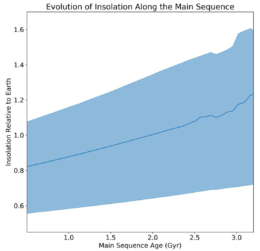Aldebaran, the brightest star in the constellation Taurus, was one of the first stars suspected to harbor an exoplanet. The presence of its planetary companion, Aldebaran b, was confirmed in 2015, and the decades of data preceding the discovery might harbor a few more surprises.

A model of acoustic oscillations, also called p-modes, which can be used to infer fundamental properties of stars through asteroseismology. The vertical extent of the oscillation has been exaggerated by a factor of 1,000. [NASA/MSFC]
A Recognizable Target
Like hundreds of other exoplanets, Aldebaran b was discovered via the radial velocity method, in which the tug of a planet causes a detectable shift in the wavelengths of absorption lines in its parent star’s spectrum.
Radial velocity measurements can reveal more than just the presence of planetary companions, however; periodic oscillations of the star itself can be hidden in the radial velocity signal. These oscillations depend on the fundamental parameters of the star: mass, radius, surface gravity, and effective temperature.
To search for stellar oscillations of Aldebaran, a team of astronomers led by Will Farr (University of Birmingham, UK) delved into more than three decades of historical radial velocity measurements.

Radial velocity measurements from the Hertzsprung SONG Telescope. The long-period planetary signal is superimposed upon the shorter-period p-mode signal. Click to enlarge. [Farr et al. 2018]
Digging Through the Data
The authors fit to the data a Keplerian model — to confirm the previously discovered planetary signal — and a Continuous Auto-Regressive Moving Average (CARMA) model — to search for stellar oscillations. In addition to verifying the presence of Aldebaran b, Farr and collaborators found evidence for stellar oscillations with maximum power at a frequency of 2.2 microhertz — well within the typical range for a red giant.
The authors followed up on these findings with high-cadence radial velocity observations from the Hertzsprung SONG Telescope and photometry from K2, the revived version of the Kepler Space Telescope. Analysis of both these datasets showed evidence of stellar oscillations consistent with those seen in the more irregularly sampled historical data.

A model of the stellar irradiance received at Aldebaran b’s orbital distance over the course of Aldebaran’s main-sequence lifetime. [Farr et al. 2018]
Getting to Know Aldebaran
Farr and collaborators were able to estimate the orbital parameters of Aldebaran b and the mass and age of its parent star. The authors find that Aldebaran has a mass of 1.16 solar masses and an age of 6.4 billion years. This suggests that while Aldebaran is currently more than 500 times more luminous than the Sun, it likely matched the Sun’s output early in its life.
At an orbital distance of 1.5 AU, Aldebaran b probably enjoyed stellar irradiance similar to modern-day Earth in the distant past — about 4.4 billion years ago. However, Aldebaran b is at least 5.8 Jupiter masses (and may be massive enough to be a brown dwarf, depending on the inclination of its orbit), so it’s unlikely to have ever hosted life as we know it.
As Farr and collaborators have shown, it’s possible to extract accurate stellar and orbital parameters from irregularly sampled radial velocity data — which is plentiful thanks to radial-velocity surveys searching for exoplanets. With this technique, we may soon know of thousands of planets around red giant stars!
Citation
“Aldebaran b’s Temperate Past Uncovered in Planet Search Data,” Will M. Farr et al 2018 ApJL 865 L20. doi:10.3847/2041-8213/aadfde


5 Comments
Pingback: AAS Nova – New
Pingback: Oscilaciones en el ojo del Toro – Observatori Astronòmic
Pingback: Oscilaciones en el ojo del Toro « SEDA / LIADA - RedLIADA - Cursos LIADA - Cielo del Mes - Fenómenos Astronómicos - RELEA
Pingback: Octubre 2018 – Observatori Astronòmic
Pingback: Oscilaciones en el ojo del Toro « Sección de Estrellas Dobles